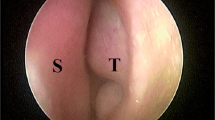Abstract
Purpose
To investigate the subjective effect of office-based blue laser therapy for inferior turbinate hypertrophy in patients with nasal obstruction.
Methods
Patients with nasal obstruction who underwent office-based blue laser for the inferior turbinate hypertrophy between October 2022 and December 2023 were included in the study. The two outcome measures used to gauge the improvement in nasal obstruction and success of surgery were the Nasal Obstruction Symptom Evaluation (NOSE) scale and the Visual Analogue Scale (VAS). Patient’s level of comfort during the procedure was also rated using a 10-point VAS scale.
Results
A total of 14 patients were included in this study. The mean age of the study group was 41.47 ± 18.52 and the F/M ratio was 4.67. All patients reported significant improvement in nasal breathing. The mean NOSE score decreased significantly from 13.07 ± 3.89 pre-operatively to 2.64 ± 2.43 post-operatively (p = 0.002). Similarly, the mean VAS score decreased from 7.43 ± 0.85 to 2.0 ± 1.57 (p = 0.002) following surgery. The procedure was well-tolerated by all participants and the mean total score ranged from 6 to 9 with an average of 7.59 ± 1.34.
Conclusion
Office-based blue laser therapy for inferior turbinate hypertrophy may be an effective treatment modality for nasal obstruction from the patient’s perspective. Although the procedures were tolerated well with no complications noted, these results should be cautiously interpreted until studies using objective measures are conducted.


Similar content being viewed by others
Data availability
The datasets generated during and/or analyzed during the current study are available from the corresponding author upon reasonable request.
References
Karamatzanis I, Kosmidou P, Ntarladima V et al (2022) Inferior turbinate hypertrophy: a comparison of Surgical techniques. Cureus. https://doi.org/10.7759/cureus.32579
Clark DW, Del Signore AG, Raithatha R et al (2018) Nasal airway obstruction: prevalence and anatomic contributors. Ear Nose Throat J. https://doi.org/10.1177/014556131809700615
Zhang K, Pipaliya RM, Miglani A et al (2023) Systematic review of Surgical interventions for Inferior Turbinate Hypertrophy. Am J Rhinol Allergy. https://doi.org/10.1177/19458924221134555
Abdullah B, Singh S (2021) Surgical interventions for Inferior Turbinate Hypertrophy: a Comprehensive Review of Current techniques and technologies. Int J Environ Res Public Health. https://doi.org/10.3390/ijerph18073441
Benninger M, Farrar JR, Blaiss M et al (2010) Evaluating approved medications to treat allergic rhinitis in the United States: an evidence-based review of efficacy for nasal symptoms by class. Ann Allergy Asthma Immunol. https://doi.org/10.1016/j.anai.2009.11.020
Hess MM, Fleischer S, Ernstberger M (2018) New 445 nm blue laser for laryngeal surgery combines photoangiolytic and cutting properties. Eur Arch Otorhinolaryngol. https://doi.org/10.1007/s00405-018-4974-8
Stewart MG, Witsell DL, Smith TL et al (2004) Development and validation of the nasal obstruction symptom evaluation (NOSE) scale. Otolaryngol Head Neck Surg. https://doi.org/10.1016/j.otohns.2003.09.016
Caffier PP, Frieler K, Scherer H et al (2008) Rhinitis medicamentosa: therapeutic effect of diode laser inferior turbinate reduction on nasal obstruction and decongestant abuse. Am J Rhinol. https://doi.org/10.2500/ajr.2008.22.3199
Cakli H, Cingi C, Güven E et al (2012) Diode laser treatment of hypertrophic inferior turbinates and evaluation of the results with acoustic rhinometry. Eur Arch Otorhinolaryngol. https://doi.org/10.1007/s00405-012-1963-1
Volk GF, Pantel M, Guntinas-Lichius O et al (2010) Prognostic value of anterior rhinomanometry in diode laser turbinoplasty. Arch Otolaryngol Head Neck Surg. https://doi.org/10.1001/archoto.2010.161
Hussain RT, Ahmad R (2022) Role of CO2 laser in the management of symptomatic hypertrophy of Inferior nasal turbinates. Indian J Otolaryngol Head Neck Surg. https://doi.org/10.1007/s12070-020-01876-z
Testa D, Motta G, Galli V et al (2006) Outcome assessment in patients with chronic obstructive rhinitis CO2 laser treated. Acta Otorhinolaryngol Ital
Supiyaphun P, Aramwatanapong P, Kerekhanjanarong V et al (2003) KTP laser inferior turbinoplasty: an alternative procedure to treat the nasal obstruction. Auris Nasus Larynx. https://doi.org/10.1016/s0385-8146(02)00104-9
Vijayakumar S, Divakaran S, Parida PK et al (2016) Potassium titanyl phosphate laser turbinate reduction in the management of allergic inferior turbinate hypertrophy: our experience. Allergy Rhinol (Providence). https://doi.org/10.2500/ar.2016.7.0151
Ravichandran SP, Ramasamy K, Parida PK et al (2020) Comparison of efficacy of potassium titanyl phosphate laser & diode laser in the management of inferior turbinate hypertrophy: a randomized controlled trial. Indian J Med Res. https://doi.org/10.4103/ijmr.IJMR_424_18
Prokopakis EP, Koudounarakis EI, Velegrakis GA (2014) Efficacy of inferior turbinoplasty with the use of CO(2) laser, radiofrequency, and electrocautery. Am J Rhinol Allergy. https://doi.org/10.2500/ajra.2014.28.4044
Harju T, Numminen J (2021) The effect of inferior turbinate surgery on nasal symptoms and inferior turbinate contractility. Am J Otolaryngol. https://doi.org/10.1016/j.amjoto.2020.102778
Acknowledgements
Not applicable.
Funding
The authors did not receive support from any organization for the submitted work.
Author information
Authors and Affiliations
Contributions
All authors contributed to the study’s conception and design. Material preparation, data collection, and analysis were performed by Jad Hosri, Yara Yammine, Patrick Abou Raji Feghali and Lana Ghzayel. The first draft of the manuscript was written by Abdul-Latif Hamdan, Jad Hosri, Yara Yammine and Nader Nawfal. Critical review and editing were done by Elie Alam and Maher Kasti. All authors commented on previous versions of the manuscript. All authors read and approved the final manuscript.
Corresponding author
Ethics declarations
Ethical approval
This study was performed in line with the principles of the Declaration of Helsinki. Approval was granted by the Institutional Review Board of the American University of Beirut (IRB ID: BIO-2022-0280).
Competing interests
Not applicable.
Additional information
Publisher’s Note
Springer Nature remains neutral with regard to jurisdictional claims in published maps and institutional affiliations.
Rights and permissions
Springer Nature or its licensor (e.g. a society or other partner) holds exclusive rights to this article under a publishing agreement with the author(s) or other rightsholder(s); author self-archiving of the accepted manuscript version of this article is solely governed by the terms of such publishing agreement and applicable law.
About this article
Cite this article
Hamdan, AL., Hosri, J., Yammine, Y. et al. Office-based blue laser therapy for inferior turbinate hypertrophy: a pilot study. Eur Arch Otorhinolaryngol (2024). https://doi.org/10.1007/s00405-024-08781-z
Received:
Accepted:
Published:
DOI: https://doi.org/10.1007/s00405-024-08781-z




